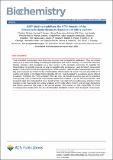Adenosine monophosphate binding stabilizes the KTN domain of the Shewanella denitrificans Kef potassium efflux system
Abstract
Ligand binding is one of the most fundamental properties of proteins. Ligand functions fall into three basic types: substrates, regulatory molecules, and cofactors essential to protein stability, reactivity, or enzyme-substrate complex formation. The regulation of potassium ion movement in bacteria is predominantly under the control of regulatory ligands that gate the relevant channels and transporters, which possess subunits or domains that contain Rossmann folds (RFs). Here we demonstrate that adenosine monophosphate (AMP) is bound to both RFs of the dimeric bacterial Kef potassium efflux system (Kef), where it plays a structural role. We conclude that AMP binds with high affinity, ensuring that the site is fully occupied at all times in the cell. Loss of the ability to bind AMP, we demonstrate, causes protein, and likely dimer, instability and consequent loss of function. Kef system function is regulated via the reversible binding of comparatively low-affinity glutathione-based ligands at the interface between the dimer subunits. We propose this interfacial binding site is itself stabilized, at least in part, by AMP binding.
Citation
Pliotas , C , Grayer , S C , Ekkerman , S , Chan , A K N , Healy , J , Marius , P , Bartlett , W , Khan , A , Cortopassi , W A , Chandler , S A , Rasmussen , T , Benesch , J L P , Paton , R S , Claridge , T D W , Miller , S , Booth , I R , Naismith , J H & Conway , S J 2017 , ' Adenosine monophosphate binding stabilizes the KTN domain of the Shewanella denitrificans Kef potassium efflux system ' , Biochemistry , vol. 56 , no. 32 , pp. 4219-4234 . https://doi.org/10.1021/acs.biochem.7b00300
Publication
Biochemistry
Status
Peer reviewed
ISSN
0006-2960Type
Journal article
Description
Funding: Wellcome Trust (WT092552MA and WT100209MA to I.R.B., J.H.N., S.M., and S.J.C.), a Biotechnology and Biological Sciences Research Council (BBSRC) grant (BB/H017917/1) (JHN), a Tenovus Scotland grant award (T15/41) (CP).Collections
Items in the St Andrews Research Repository are protected by copyright, with all rights reserved, unless otherwise indicated.

